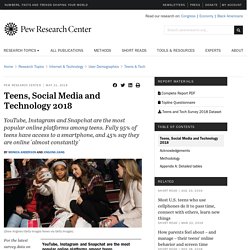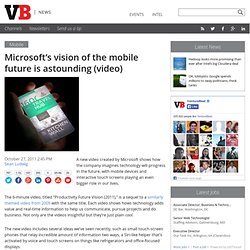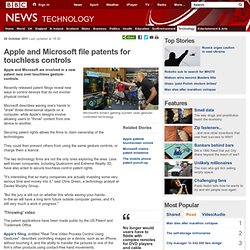

Teens, Social Media & Technology 2018. Until recently, Facebook had dominated the social media landscape among America’s youth – but it is no longer the most popular online platform among teens, according to a new Pew Research Center survey.

Today, roughly half (51%) of U.S. teens ages 13 to 17 say they use Facebook, notably lower than the shares who use YouTube, Instagram or Snapchat. This shift in teens’ social media use is just one example of how the technology landscape for young people has evolved since the Center’s last survey of teens and technology use in 2014-2015. Most notably, smartphone ownership has become a nearly ubiquitous element of teen life: 95% of teens now report they have a smartphone or access to one. These mobile connections are in turn fueling more-persistent online activities: 45% of teens now say they are online on a near-constant basis.
The survey also finds there is no clear consensus among teens about the effect that social media has on the lives of young people today. Pinterest Data Analysis: An Inside Look. Pinterest is the hottest young site on the internet.

In the past six months, the social sharing tool has gone from effectively non-existent to one of the top 100 sites on the web (and is on track to break into Alexa’s Top 50). Pinterest’s traffic charts aren’t hockey sticks– they’re rocket ships. In our experience, when traffic is growing that sharply there is often something even more amazing going on under the hood. We wanted to see if the usage and engagement numbers for Pinterest were as remarkable as its traffic and gain insights into exactly what was driving growth. Unfortunately, the company has kept very quiet when it comes to its data. Tired of waiting, we took things into our own hands using some clever scripting and our secret sauce for analytics: RJMetrics.
Pinterest is retaining and engaging users as much as 2-3x as efficiently as Twitter was at a similar time in its history.Pins link to a tremendously large universe of sites. How We Did It. Revolutionary User Interfaces. A few years ago, around the middle of the last decade, the mobile phone market was characterized by the rivalry between a few established vendors.

These were Nokia, Samsung, LG, Motorola and Sony Ericsson. These incumbent companies had a broad portfolio of devices including smartphones and feature phones and basic phones. Many also sold networking equipment and were deeply engaged with their customers, network operators. There was also a set of entrants who offered only smartphones. They were quirky. In 2007 something happened which changed the industry. In a few short years the rivalry between incumbent handset makers has evolved into a rivalry between mobile platforms where the incumbents were caught in an increasingly unprofitable role of hardware integrators. How did large, powerful, smart companies let this happen? It happened despite having a clear, front row view of the transition of the industry from mobile voice to mobile computing. That is now ancient history. Microsoft’s vision of the mobile future is astounding (video) A new video created by Microsoft shows how the company imagines technology will progress in the future, with mobile devices and interactive touch screens playing an even bigger role in our lives.

The 6-minute video, titled “Productivity Future Vision (2011),” is a sequel to a similarly themed video from 2009 with the same title. Each video shows hows technology adds value and real-time information to help us communicate, pursue projects and do business. Not only are the videos insightful but they’re just plain cool. The new video includes several ideas we’ve seen recently, such as small touch-screen phones that relay incredible amount of information two ways, a Siri-like helper that’s activated by voice and touch screens on things like refrigerators and office-focused displays. Many different concepts are on display as the video shifts from person to person, and the scenes connect in one world-spanning story.
Watch the amazing full video below: Apple and Microsoft file patents for touchless controls. 28 October 2011Last updated at 15:30 Microsoft's Kinect gaming system uses gesture-controlled technology Apple and Microsoft are involved in a new patent race over touchless gesture-controls.

Recently released patent filings reveal new ways to control devices that do not involve physical contact. Microsoft describes waving one's hands to "draw" three-dimensional objects on a computer, while Apple's designs involve allowing users to "throw" content from one device to another. Securing patent rights allows the firms to claim ownership of the technologies. They could then prevent others from using the same gesture controls, or charge them a licence. The two technology firms are not the only ones exploring the area.
"It's interesting that so many companies are actually investing some very serious time and money into it," said Chris Green, a technology analyst at Davies Murphy Group. Continue reading the main story “Start Quote. Home – Watch this space : France. The Next Wave: Local Games? Facebook describes how to design the best social games. ArielyWired.pdf (Objet application/pdf)